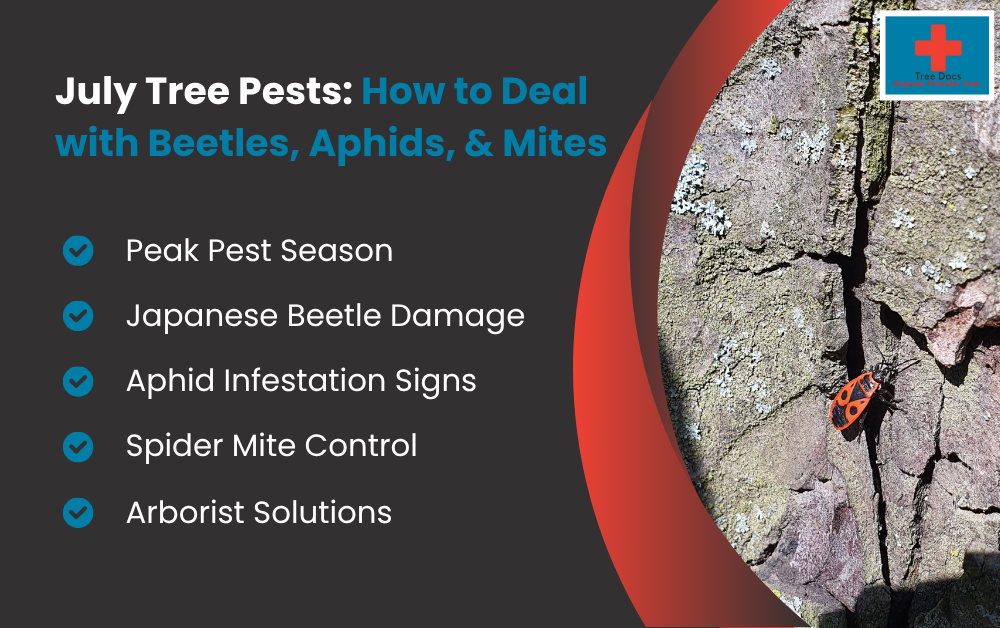Summer may be in full swing, but your trees could be under attack—and you might not even know it. July tree pests like Japanese beetles, aphids, and spider mites thrive in the heat and humidity of Northeast Ohio. These tiny invaders can cause significant damage to your trees in a short amount of time, weakening their health right when they should be flourishing. At Tree Docs, we help homeowners and property managers identify and treat pest problems early—before they escalate into costly issues. Here’s what you need to know about the top offenders this July and how to keep your trees healthy.
Why July Is Peak Season for Tree Pests
Heat + Humidity = Ideal Conditions
July brings soaring temperatures and increased moisture, both of which create perfect breeding grounds for pests. Many insects that overwinter as larvae emerge in late spring and explode in population by midsummer.
Increased Pest Activity in Ohio Landscapes
In Northeast Ohio, trees are especially vulnerable during July. Between drought stress, storm damage, and intense sun exposure, trees are already working hard to survive—making them easy targets for pests looking for food and shelter.
How Pest Damage Compounds Summer Stress
Infestations don’t just look bad. They reduce a tree’s ability to photosynthesize, fight off disease, and recover from environmental stress. Left untreated, July tree pests can open the door to long-term decline or even death.
Japanese Beetles: Pretty but Destructive
How to Identify Them
Japanese beetles are small, metallic-green insects with copper-colored wings. Though they may look beautiful up close, they are ruthless feeders. They skeletonize leaves—eating the tissue between veins until only a lace-like structure remains.
Trees They Target
They love over 300 plant species, but their favorites include:
- Maples
- Lindens
- Elms
- Fruit trees like apples and cherries
Control Options
- Handpicking: Drop them in a bucket of soapy water early in the morning when they’re slow.
- Beetle traps: Use cautiously—these may attract more beetles than they trap.
- Systemic insecticides: Tree Docs offers professional treatments that protect your trees from the inside out.
Aphids: The Sticky Problem on New Growth
What to Look For
Aphids are soft-bodied insects that gather in large groups on leaves and stems, especially around new growth. They leave behind a sticky substance called honeydew, which leads to black sooty mold. Signs include:
- Curling or yellowing leaves
- Shiny, sticky residue
- Presence of ants (they farm the aphids for honeydew)
Common Aphid Hosts
- Tulip trees
- Maples
- Oaks
- Many ornamental shrubs and perennials
Treatment Tips
- Natural predators: Ladybugs and lacewings eat aphids.
- Horticultural oils and soaps: Safe for most trees when used properly.
- Injections and sprays: Tree Docs can apply tree-safe, targeted treatments to stop aphids fast.
Spider Mites and Their Summer Damage
Hot, Dry Weather = Mite Explosion
Unlike some pests that need moisture, spider mites love dry, dusty conditions. Their populations can grow quickly, especially in trees that are already water-stressed.
Signs of Infestation
- Leaves look speckled, bronzed, or faded
- Fine webbing on leaves and branches
- Premature leaf drop
What Works
- Hose off the leaves regularly to discourage mites
- Miticides for serious infestations
- Promote tree health through watering, mulching, and soil care
At Tree Docs, we can identify which type of mite you’re dealing with and apply the right treatment for your trees and property.
When to Call a Certified Arborist
DIY Treatments vs Professional Plant Health Care
Some minor pest issues can be managed at home, but many infestations go deeper than what you see. Misusing sprays or products can even harm beneficial insects or damage the tree.
Benefits of Early Intervention
The earlier you address July tree pests, the better the outcome. Proactive plant health care can save trees from long-term damage and restore their vigor for the growing season.
How Tree Docs Diagnoses and Treats July Tree Pests
- Certified arborists evaluate tree species, soil health, and pest pressure.
- Custom treatment plans, including trunk injections, soil drenches, or organic sprays.
- Monitoring and follow-ups to make sure the problem is resolved for good.
Don’t Let Pests Win This Summer
Don’t wait for chewed leaves and sticky branches to tell you something’s wrong. If you suspect your trees are struggling with pests, now’s the time to act. Tree Docs offers fast, expert help for July tree pests across Northeast Ohio. Our certified arborists can diagnose the problem, recommend the right solutions, and keep your trees healthy all summer long.
Call Tree Docs today or schedule your plant health evaluation online to beat the pests before they beat your trees.



